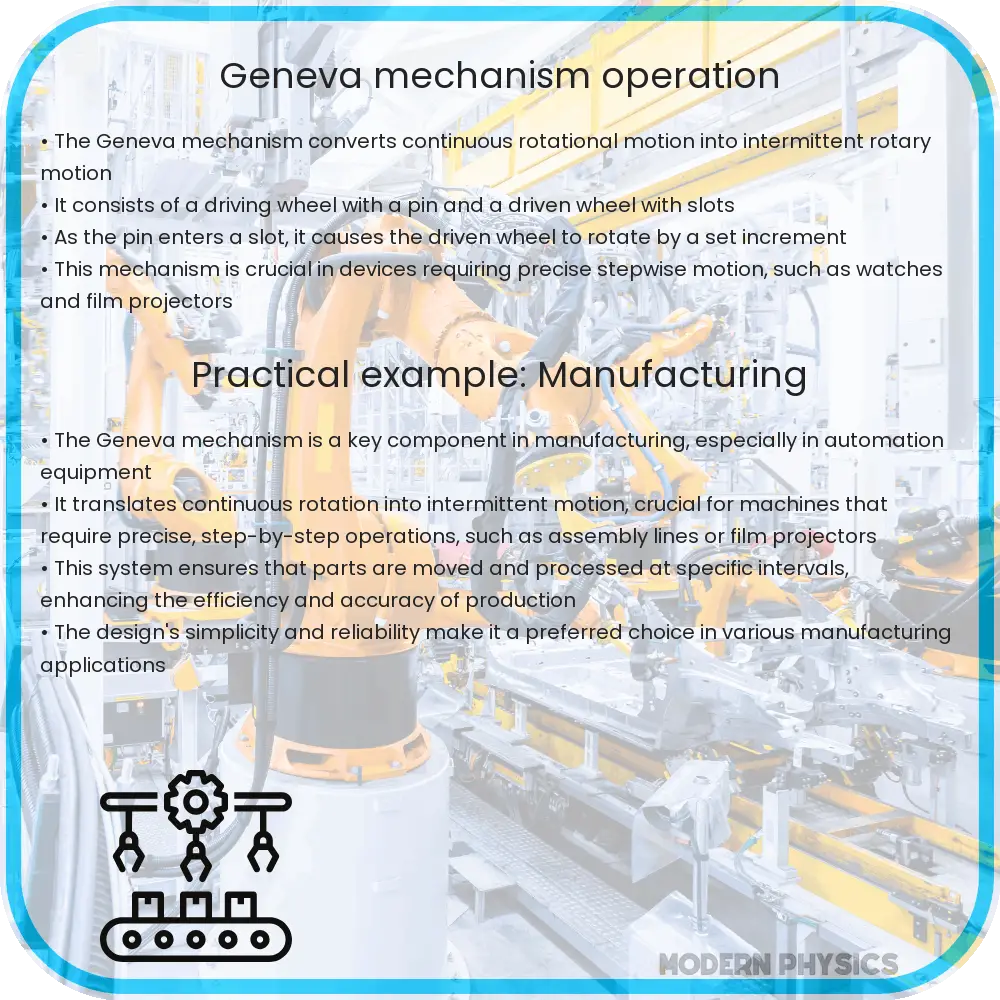Explore the Geneva Mechanism: uncover its design, precision, applications in modern technology, and future prospects in mechanical engineering.

Understanding the Geneva Mechanism: An Overview of Its Precision, Timing, and Dynamics
The Geneva mechanism is a fundamental component in the realm of mechanical engineering, renowned for its ability to produce precise, intermittent motion from a continuous rotation. This intriguing mechanism, often seen in watches and indexing equipment, stands out for its unique design and reliable performance.
The Design and Operation of the Geneva Mechanism
At the core of the Geneva mechanism is a rotating drive wheel and a driven wheel, often referred to as the Geneva wheel. The drive wheel features a pin that extends radially, engaging with slots on the Geneva wheel. As the drive wheel rotates, the pin enters a slot on the Geneva wheel, rotating it by a set angle before disengaging. This process results in the intermittent movement of the driven wheel, typically by a fraction of a full rotation.
Precision and Accuracy in the Geneva Mechanism
The precision of the Geneva mechanism lies in its design. The number and shape of the slots on the Geneva wheel dictate the angle of rotation and the number of stops. This precision is crucial in applications where exact positioning is vital, such as in film projectors or automated assembly lines.
Timing and Dynamics
The timing of the Geneva mechanism is determined by the interaction between the drive wheel and the Geneva wheel. The smooth engagement and disengagement of the pin and slots ensure minimal wear and tear, contributing to the mechanism’s longevity. Additionally, the design minimizes sudden movements, reducing the risk of mechanical shock.
Challenges and Considerations
While the Geneva mechanism offers precision and reliability, it also presents certain challenges. The need for precise manufacturing and alignment is paramount to avoid jamming or damage. Moreover, the mechanism’s dynamics can be influenced by factors such as friction and inertia, which need to be carefully managed in high-speed applications.
In conclusion, the Geneva mechanism remains a vital component in various mechanical applications. Its ability to transform continuous motion into controlled, intermittent motion makes it indispensable in fields requiring precision and reliability. Understanding its operation, dynamics, and potential challenges is crucial for anyone involved in mechanical design or engineering.
Advanced Applications and Innovations in Geneva Mechanisms
The versatility of the Geneva mechanism extends beyond traditional uses, finding innovative applications in modern technology. Robotics, precision instrumentation, and even spacecraft mechanisms often leverage this mechanism for its reliability and exactitude. Recent advancements in materials science and computer-aided design have further enhanced the potential of Geneva mechanisms, allowing for more compact, efficient, and durable designs.
Optimization and Customization
Optimizing a Geneva mechanism involves tailoring its design to the specific needs of an application. This might include customizing the number of slots on the Geneva wheel, adjusting the size and shape of the components, or selecting materials that offer the best balance of strength and weight. Advanced manufacturing techniques like 3D printing have opened new avenues for creating complex, customized Geneva mechanisms with greater ease and precision.
Overcoming Limitations through Design Innovations
Engineers continue to address the limitations of the Geneva mechanism, such as the impact of high-speed operations and the potential for wear and tear. Innovations in lubrication technologies, the use of wear-resistant materials, and the incorporation of shock-absorbing features are some of the ways these challenges are being met. Additionally, integrating electronic controls can enhance the precision and adaptability of the mechanism, allowing for more refined control over its motion and timing.
Future Prospects and Potential
Looking ahead, the Geneva mechanism is likely to see continued evolution, especially as new materials and technologies emerge. Its fundamental principle may be adapted and integrated into more complex systems, particularly in fields like automation and renewable energy, where precision and reliability are paramount. The ongoing research and development in this area promise to unveil even more sophisticated and efficient versions of this timeless mechanism.
Conclusion
In summary, the Geneva mechanism is a marvel of mechanical engineering that combines precision, timing, and efficiency in a deceptively simple design. Its applications span a wide range of industries, from watchmaking to high-tech robotics. The ongoing advancements in design and materials are set to enhance its capabilities further, ensuring that this classic mechanism will remain relevant and useful in the future of mechanical design and engineering. With its unique combination of reliability, precision, and versatility, the Geneva mechanism continues to be a cornerstone in the world of mechanical systems, driving innovation and efficiency in countless applications.
